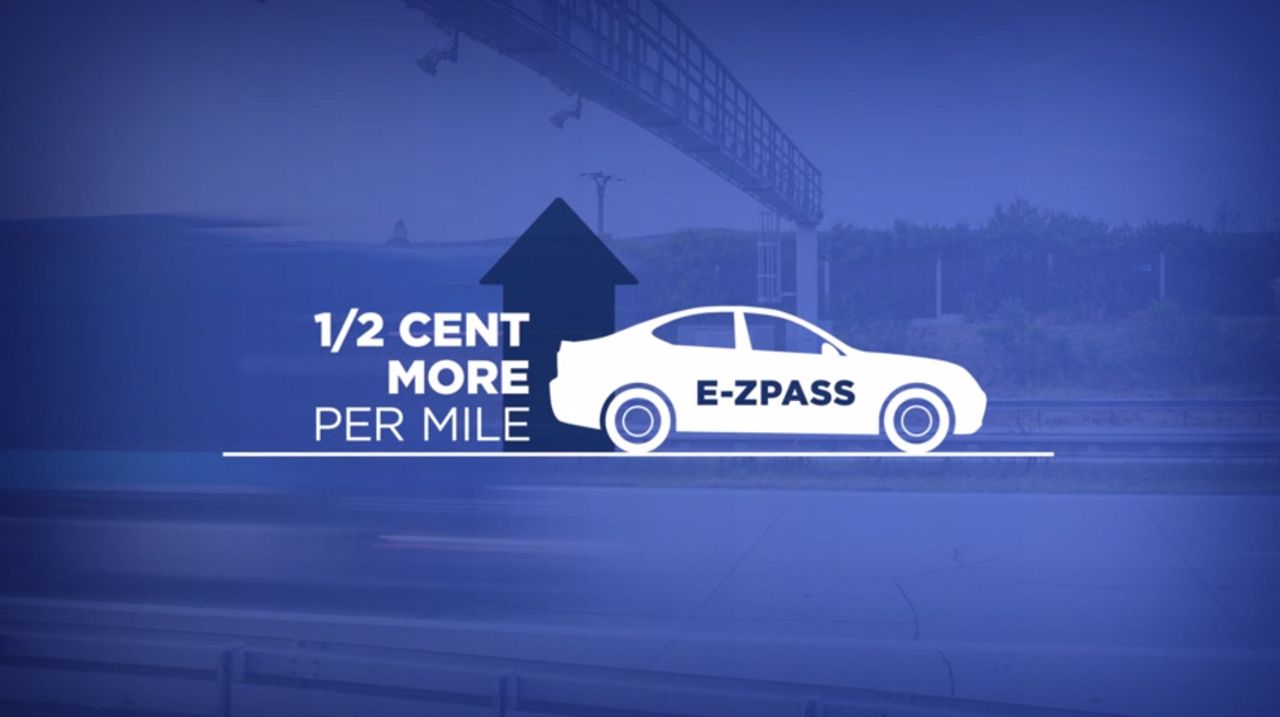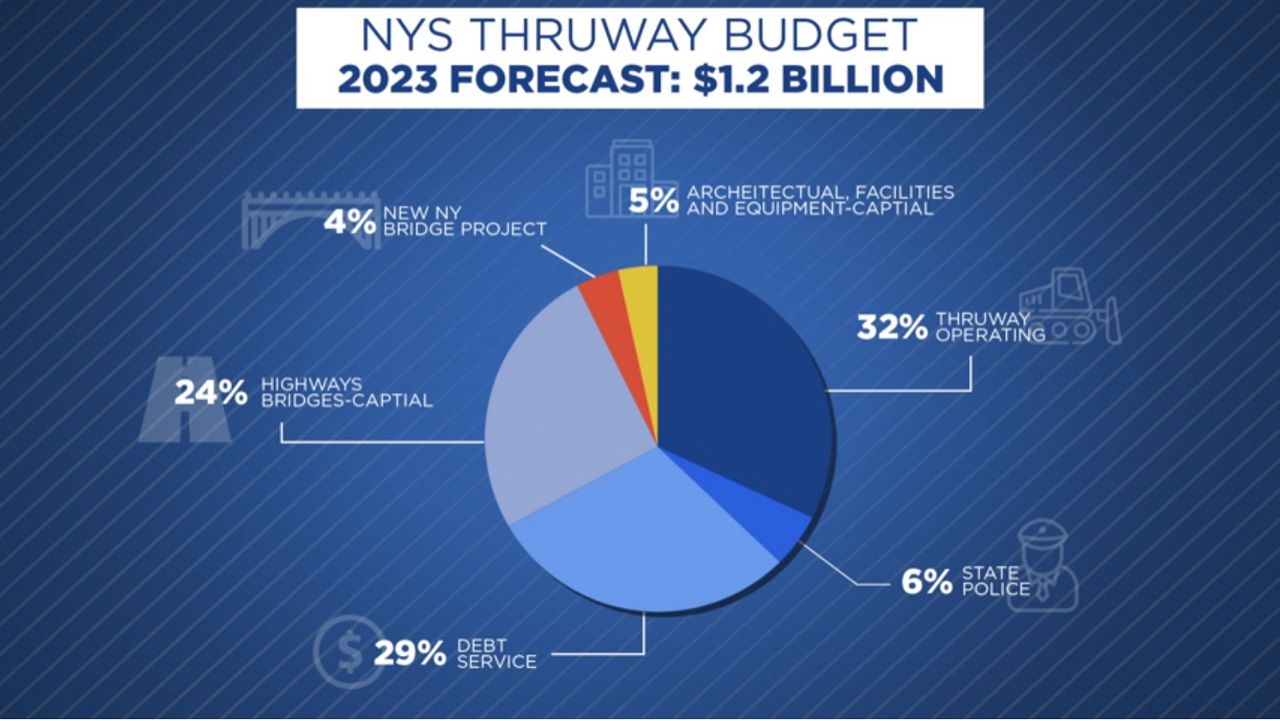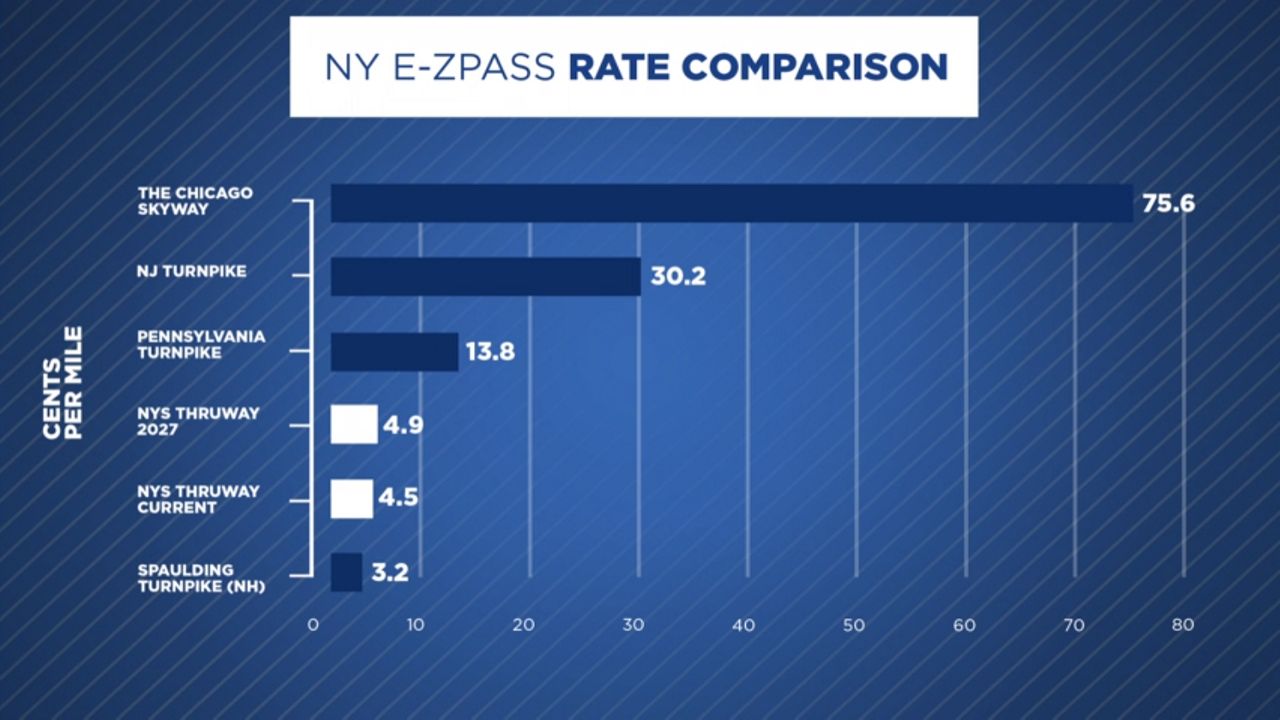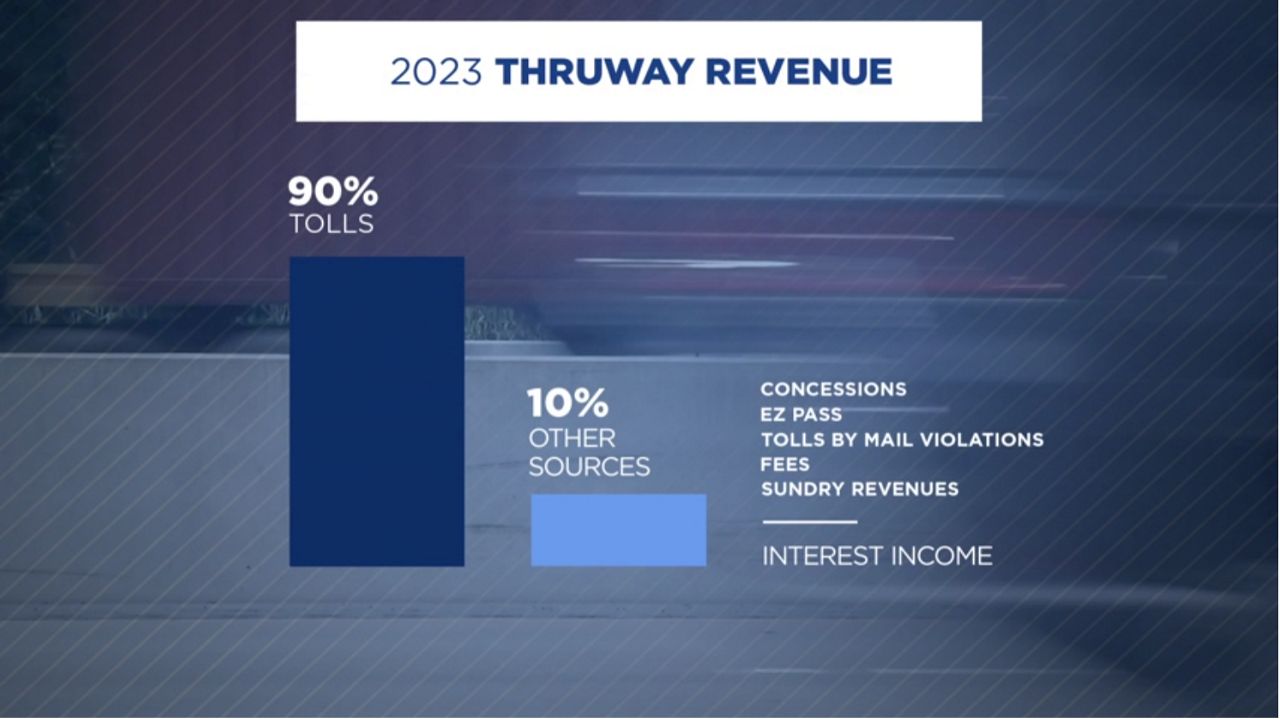Drivers in New York paid more than $800 million in state Thruway tolls last year. But the New York State Thruway Authority has proposed two toll rate increases over the next four years, prompting a bipartisan backlash that called for the hike to come to a halt.
The first jump would be 5% in 2024 followed by a second 5% increase in 2027, said now-former state Thruway Authority Chief Financial Officer Matthew Howard, who granted a rare sit-down interview with Spectrum News 1.

After both increases, a standard passenger vehicle owner with an E-Z Pass would pay about a half-cent more per mile; non-E-Z Pass holders, 3 1/2 cents more; and tolls by mail and non-E-Zpass holders, just under 3 cents more per mile. For perspective, that would cost E-Z Pass holders an extra 8 cents to drive from Hudson to Canaan, 10 cents from Verona to Syracuse and 11 cents from Geneva to Rochester.
“The goal is that we would be able to support our operating and capital needs over the course of the next decade. And I think we could do that in a way where this adjustment program will support, you know, that activity,” said Howard, who has since moved over to the New York State Division of the Budget.
What You Need To Know
- The New York State Thruway is 496 miles long to the Pennsylvania line and spans 19 counties
- The Thruway generates $800 million a year in toll revenues and has proposed increases prices to raise revenue
- The plan has sparked opposition from the public
Reasons for the proposed increase
The Thruway Authority’s argument for the adjustment comes down to two reasons. First, the Thruway is aging.
“The system in its entirety was all built around the same time in the 1950s. And as a result, we see a lot of the infrastructure aging and reaching a point where replacement is going to be required,” said Howard, adding that 80% of the roadway relies on its original foundation poured when it was first built.
“We've identified that there's roughly about 85 bridges that could be in line for replacement over the course of the next decade," Howard said. "You know, the estimate on the cost of that today, I think, is about $800 million. If we delay on that, the cost will only go up relative to the roadway itself.”
The funding plan will allow the authority to start planning for work to continue to ensure driver safety, he said.
EXTENDED INTERVIEW: HOWARD DEFENDS TOLL HIKE
Second, the cost of maintenance is rising.
“A great example is from 2010 through today, the cost of salt has increased by about 40%. Another example is fuel oil and things like that have increased by closer to 50%,” said Howard.
That’s why the Thruway Authority is turning to toll payers, he said.
“The system is fully supported by tolls. In the past, we haven't received COVID relief funds, allocations of any federal infrastructure funds on an operating basis. We don't receive state support,” said Howard.
Howard said the state Thruway Authority was hit hard by the COVID-19 pandemic. Traffic and toll revenue in 2020 dropped by about 17%, he said.
"It was the largest decline that we saw of any sort in like the last 40 years. That number in 2020 was about a $125 million reduction in that year alone. That money's gone. It's not coming back as we've seen and recovered from COVID," Howard said.
Over five years ending in 2025, the Thruway Authority estimates it will lose about $240 million compared to pre-COVID projections, Howard said.
EXTENDED INTERVIEW: COVID’S IMPACT ON THE THRUWAY
Traffic and revenues, however, have since bounced back. In fact, commercial traffic in 2022 increased by about 21% higher than it was prior to COVID, he said.
"A big reason for that, if you think about it, has to do with the fact that things like online shopping and what not increased and resulted in more trucks on the road," Howard said.
Still, he said the authority isn't relying on disproportionate growth in commercial traffic.
'You can only squeeze the little guy so long'
But Mike Sheridan, the owner of Sheridan Brothers Moving and Storage is also dealing with rising costs.
The Rochester-based family moving company got off the ground with next to nothing in the early 1980s and now owns about 22 trucks. It's a relatively small operation, so when Sheridan heard about proposed rate hikes on the Thruway, he worried about its bottom line.
“We’ve got additional labor costs, we’ve got additional fuel costs, additional utility costs, rent costs,” said Sheridan.
The company also faces dwindling revenue due to inflation.
“We’ve got trucks up and down the Thruway, on average, every week,” said Sheridan. “There’s only so far we can be stretched before you’re going to start seeing small businesses shutting down. You can only squeeze the little guy so long.”
EXTENDED INTERVIEW: MIKE SHERIDAN WORRIES ABOUT NEGATIVE IMPACT OF TOLL INCREASE
The small business owner feels the state Thruway Authority is kicking him when he’s down.
“It seems like they always have their hand out,” said Sheridan, “and it was supposed to be paid off so many years ago.”
How we got here
Gov. Thomas Dewey broke ground on the New York State Thruway in 1946, selling the superhighway as the future backbone of New York state. In 1950, the state sold $972 million in bonds to pay for construction, which would be repaid using toll revenue.
Once the bonds were paid off in 1996, the intention was for the Thruway to become a freeway. But a task force formed in 1991 by Gov. Mario Cuomo recommended tolls stay in place to continue funding the Thruway’s maintenance, without raising taxes.
For more than two decades, that has been the case.

According to the Thruway Authority, last year, every toll dollar collected was spent. This year’s forecasted budget is $1.2 billion. The largest expenditure – 32% – is operating costs that includes day-to-day operations plus snow plowing and ice treatment.
Paying off debt is the second costliest at 29%. Road and bridge projects account for 24% of the budget, followed by the Thruway's dedicated New York State Police Troop T unit. Facilities, equipment and the Mario Cuomo Bridge project make up the rest.

Questions from DiNapoli
The proposed toll increases have also faced criticism from state Comptroller Tom DiNapoli, who released a report earlier this year that said, “toll increases should be last option.”
DiNapoli said he believes there's not enough transparency in the state Thruway Authority’s capital needs and finances. The comptroller also said the state Thruway Authority did not perform a comprehensive assessment of operating needs and expenses prior to proposing the toll hikes.
Howard responded to DiNapoli, saying, “Well, I think we did submit a report, as I just mentioned, that was compliant with state law."
He said the authority provides monthly financial reporting and has an outside auditor that reviews its financial statements and a capital program that's approved by a board of directors on a five-year basis.
"That's all available for the public to see,” Howard said. “I'm not sure how much further we need to go relative to that."
In response to DiNapoli's suggestion that the authority take advantage of non-toll revenue options, Howard said it is trying to do that. He said the authority's fiber optic network that began operating a couple of years ago increased revenue by $8-$11 million.
“Again, there's a lot of confusion out there that there are other sources of revenues that we receive," Howard said. "The fact of the matter is 90% of our revenues come directly from our toll payers."

The state Thruway Authority is now accepting public comments on the proposed toll increases. That will last several months, and the Thruway’s board of directors will vote on final approval by the end of the year.
If passed, the first toll adjustment goes into effect Jan. 1, 2024, followed by the second on Jan. 1, 2027.





